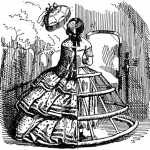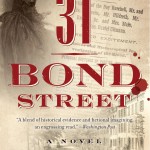By Ellen Horan (Guest Contributor)
My novel, 31 Bond Street, explores the fate of a well-do widow with two teenage daughters, Emma Cunningham (still considered youthful and attractive in her 30’s), during a sensational trial for murder. By reading the newspapers of 1857 to research the actual case that it is based upon, I was thrust back into that era. When I immersed myself, I found that ‘day to day’ existence was rarely explained in the newspaper – as so much about contemporary life was taken for granted. One of my biggest curiosities was ‘how did women ever manage to wear hoop skirts?’
What is a “Hoop Skirt”?
First of all, 1857 was the year flexible metal hoop was patented and came to market and it created a huge sensation. It was made of foldable loops of steel, and could collapse for storage, and then pop open with the touch of a spring. Women had been burdened with heavy skirts that were kept fashionably full with wooden hoops and layer upon layer of crinolines or horsehair, so the new hoop skirt was a modern revelation. It was a huge hit because it lightened the load. We think, from a feminist perspective, that such items were ‘suffered’ by women, burdening them and slowing them down, but hoops were hugely popular among women. They were relieved of the weight of multiple layers of petticoats and heavy crinolines and bone or wooden stays in their skirts. The metal ‘cage’ hoop seemed light and liberating by comparison. Movement became easier. Wearing a metal hoop skirt was often compared to ‘sailing’ since there was nothing underneath, and your skirt fabric was stretched around a brace, much like a sail.
Who Wore Hoop Skirts?
Women wore hoop dresses to fancy events and parties, but also under a daytime dress known as ‘the promenade dress’ for shopping and other activities. An evening promenade was something all New Yorkers turned out for in the days before the Civil War. After work, all classes loved to link arms and walk up and down the avenues, with women showing off their hoops. During 1857, the larger the hoop, the more fashionable, the skirts became wildly elaborate and covered with follies like beading and fringe and ruffles. New synthetic dyes had recently been invented creating vivid clashing colors like purple and orange. Skirts would grow to wider and wider circumferences, often taking up 20 yards of fabric, stretched out like gigantic lampshades. Women were crazy for these latest fashion fads, and metal hoops were in huge demand, with women outside the cities anxiously awaiting new shipments.


